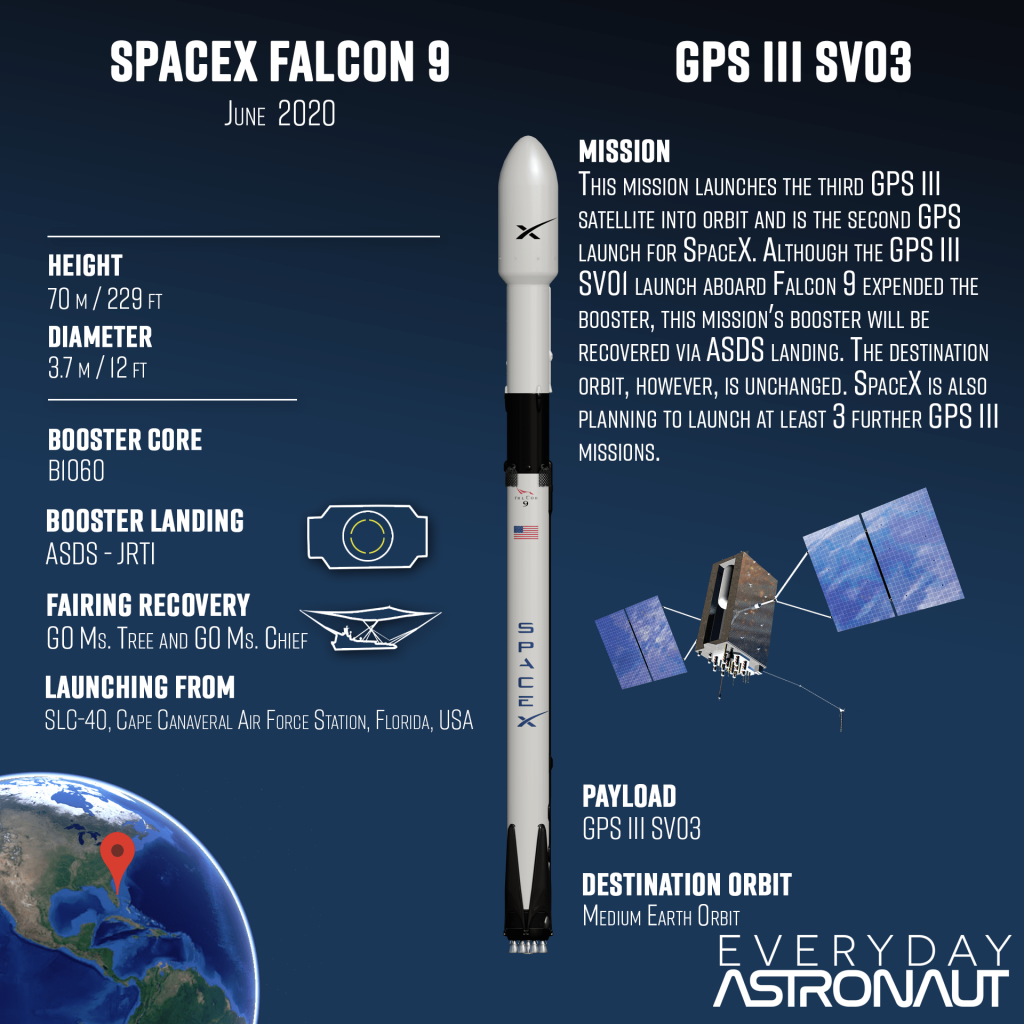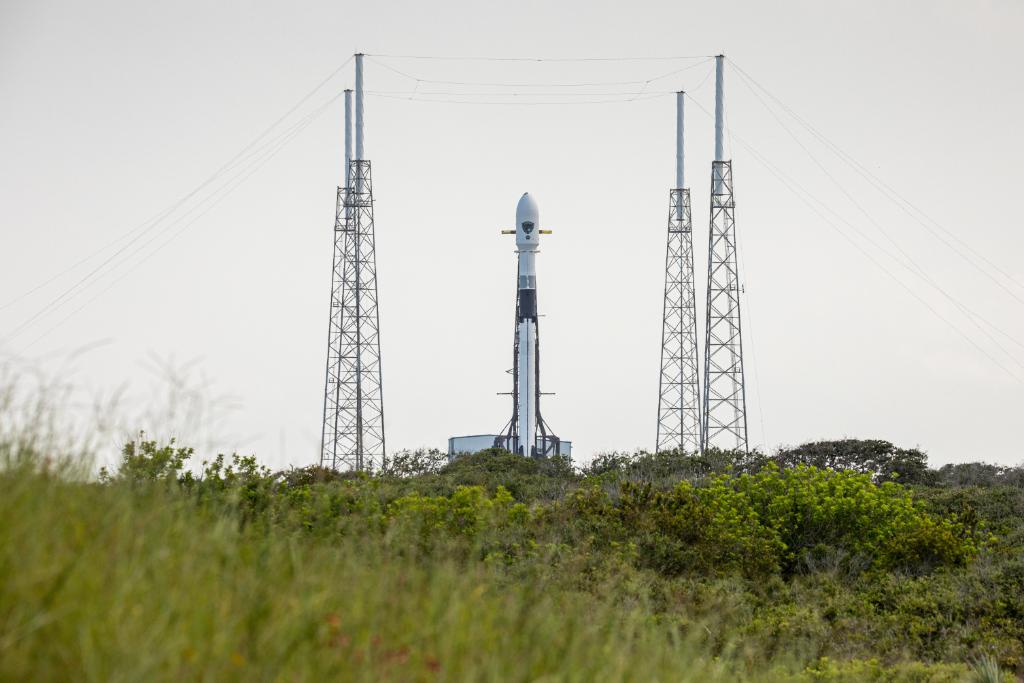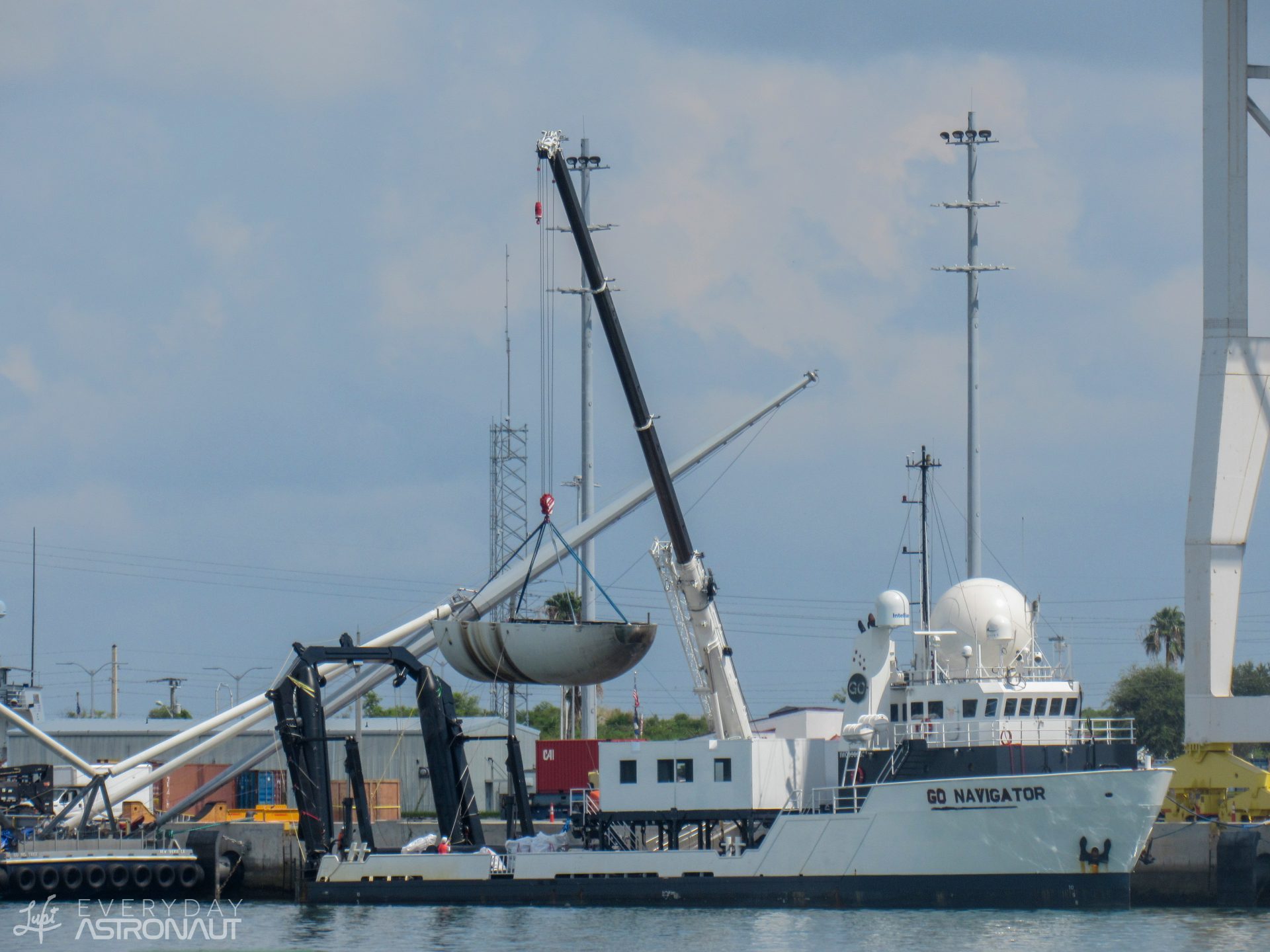What’s all this mean?
A SpaceX Falcon 9 rocket will launch the GPS Block III SV03 satellite for the American military. SV03 is part of the United States Space Force’s new generation GPS constellation. It is launching on June 30, at 20:10:46 UTC, from Space Launch Complex-40 (SLC-40) at the Cape Canaveral Space Force Station (CCSFS).
Lift Off Time (Subject to change) |
June 30, 2020 – 20:10:46 UTC | 16:10:46 EDT |
|---|---|
Mission Name and what it is |
GPS Block III SV03. The third Third Generation Global Positioning System (GPS) satellite |
Launch Provider (What rocket company is launching it?) |
SpaceX |
Customer (who’s paying for this?) |
United States Space Force |
Rocket |
Falcon 9 Block 5 B1060.1, Second Stage B2100 |
Launch Location |
Space Launch Complex 40 (SLC-40) at Cape Canaveral Space Force Station in Florida |
Payload mass |
3,880 kg (8,553 pounds) |
Where’s the satellite going? |
Medium Earth Orbit – 20,200 km (12,500 miles), 55° inclination |
How’s the weather? |
The weather is currently 60% go for launch |
Will they be attempting to recover the first stage? |
Yes |
Where will the first stage land? |
The booster will land downrange on SpaceX’s autonomous spaceport drone ship (ASDS) Just Read The Instructions |
Will they be attempting to recover the fairing? |
SpaceX is not trying to catch the fairings, but will fish both halves out of the water. |
This will be the: |
|
Where to watch |
SpaceX official Stream
If you happen to be in the area, here’s where you can watch in person! |

What is the GPS constellation?
GPS, or Global Positioning System, is a medium-Earth orbit satellite constellation which is operated by the United States Space Force. It is America’s global navigation satellite system, providing worldwide coverage for geolocation and time. Currently, there are 31 active GPS satellites in orbit, with an additional 25 planned.

Out of those 31 active satellites, there are four different models, and two different blocks. From newest to oldest there are two operational GPS Block IIIs, which were launched in 2018 and 2019. There are also 12 operational GPS Block IIFs, which launched from 2010-2016. Next, 7 operational GPS Block IIR-Ms; they launched from 2005-2009. Finally, there are 10 operational Block IIRs, launched between 1997 and 2004. Learn more about the block versions here.
The GPS constellation brings impressively accurate readings to the civilian population, with even more accuracy for the branches of the military. For the civilian population, GPS provides an impressive 500-30 cm of accuracy. This is especially impressive as each satellite is a circular orbit with an orbital height of 20,180 km. GPS Block III plans to improve on this even further.
What is GPS Block III?
GPS Block III is the third major iteration of the GPS satellite. Each satellite was designed and manufactured by Lockheed Martin. Each satellite is designed to have a 15 year lifespan, but based on previous blocks lasting over twice as long as their lifespan, each satellite will likely last longer.
The goal of GPS Block III was to provide enhanced signal reliability, accuracy, and integrity. The satellites will build upon, or improve, features included on the Block IIR-M and IIF satellites including:
- L1C signal on the 1575.42 MHz L1 frequency
- L2C signal on the 1227.6 MHz L2 frequency
- L5 “Safety of Life” signal on the 1176.45 MHz L5 frequency
- Military M-code
The first satellite was supposed to launch in 2014, but experienced many delays that pushed the first launch back to December 2018. The 10th, and final, GPS Block III satellite is expected to launch NET Q2 2023.

What is Falcon 9 Block 5?
SpaceX’s Falcon 9 rocket first flew in 2010. Since that time, Falcon 9 has flown for a total of 88 times. 84 of those launches being fully successful, one partially successful (CRS-1), one ground anomaly (AMOS-6), and one in-flight failure (CRS-7). GPS Block III SV03 will be the launch vehicle’s 89th flight. Over the years, it has gone through several upgrades and iterations, not including the Falcon Heavy. The current version is the Falcon 9 Block 5, introduced in 2018 and is now the main version in operation today.
The Block 5 is the final iteration of the Falcon 9 and rated to carry humans into space. Block 5’s goal was to apply all the lessons that SpaceX learned into a human-rated, reusable rocket, capable of sending Crew Dragon into orbit. .

Human-rating
The first change NASA required to human-rate the Falcon 9 was to put it into a design freeze. Before Block 5, no two Falcon 9s were the same, according to a SpaceX representative. Because of these continual improvements, NASA required SpaceX to fly seven missions in a row with no changes to the launch vehicle.
The second major change required the addition of a redesigned carbon over-wrapped pressure vessel (COPV). It was COPVs in the upper stage that caused the two previous Falcon 9 failures (AMOS-6 and CRS-7).
Reusability Tweaks
There were also many modifications in the Block 5 booster stage related to better reusability that were not critical for human-rating. SpaceX reinforced the landing legs, upgraded the grid fins, added a carbon fiber interstage, added a heat resistant external paint, and upgraded the engines. For more information about the changes in Block 5, and the other Blocks of the Falcon 9, check out this video by the Everyday Astronaut:

What is the gray stripe on the second stage?
This GPS mission marks the return of the gray stripe around the RP-1 tank on the second stage. The stripe first appeared on July 25, 2019, for the launch of CRS-18.
As objects in space are really hot while in the sun, and really cold while in a shadow, maintaining the cryogenic temperature of liquid oxygen is no easy feat. SpaceX has added the gray stripe because it acts as a heatsink for the LOX tank, warming up the RP-1 instead of the LOX. This is done to ensure that the propellent temperatures are good for a second engine start (SES) over an hour after launch. This is ideal as RP-1’s boiling point as around 220 K higher and can handle the slight increase in temperature. Furthermore, RP-1 has a higher specific heat capacity further increasing the stripe’s effect.

Falcon 9 Booster B1060
The booster supporting the GPS Block II SV03 mission is B1060. To prepare for this launch, the booster was static fired on June 25, 2020. This is this boosters first flight, hence its designation is B1060.1
Fairing Reuse
SpaceX is the first company to recover and reuse fairings. SpaceX will not be attempting to catching the fairing halves on this launch, but they will be fished out of the water — one half on Go Ms. Tree and the other on Go Ms. Chief.

GPS Block III SV03 First Stage Landing
After boosting the second stage, along with its GPS Block 3 satellite toward orbit, the first stage will perform an entry burn. The purpose for the burn is to slow the vehicle down to prepare it for atmospheric reentry. The booster will then land approximately 630 km downrange aboard SpaceX’s Autonomous Spaceport Done Ship (ASDS) Just Read The Instructions.
GPS Block III SV03 Full Mission Profile
Countdown
Hr/Min/Sec Event
– 00:38:00 SpaceX Launch Director verifies go for propellant load.
– 00:35:00 RP-1 (rocket grade kerosene) loading underway.
– 00:35:00 1st stage LOX (liquid oxygen) loading underway
– 00:16:00 2nd stage LOX loading underway
– 00:07:00 Falcon 9 begins engine chill prior to launch
– 00:01:00 Command flight computer to begin final prelaunch checks
– 00:01:00 Propellant tank pressurization to flight pressure begins
– 00:00:45 SpaceX Launch Director verifies go for launch
– 00:00:03 Engine controller commands engine ignition sequence to start
– 00:00:00 Falcon 9 Liftoff
Launch, Landing, and Satellite Deployment*
Hr/Min/Sec Event
00:01:11 Max Q (moment of peak mechanical stress on the rocket)
00:02:31 1st stage main engine cutoff (MECO)
00:02:35 1st and 2nd stages separate
00:02:42 2nd stage engine start (SES-1)
00:03:28 Fairing deployment
00:06:45 1st stage entry burn complete
00:08:07 2nd stage engine cutoff (SECO-1)
00:08:30 1st stage landing
01:03:28 2nd stage engine start (SES-2)
01:04:13 2nd stage engine cutoff (SECO-2)
01:29:14 GPS Block III SV03 deployment
* All times are approximate






hello tim dodd
GPS Block III SV03 is currently marked with booster landing on OCISLY. Should that not be JRTI?
The schedule shows a blacksky 6 and starlink 9 deployment. Those should probably be removed as I believe those were from Friday’s scrubbed mission.
Thanks!
What will happen with the second stage? Will be de orbited?